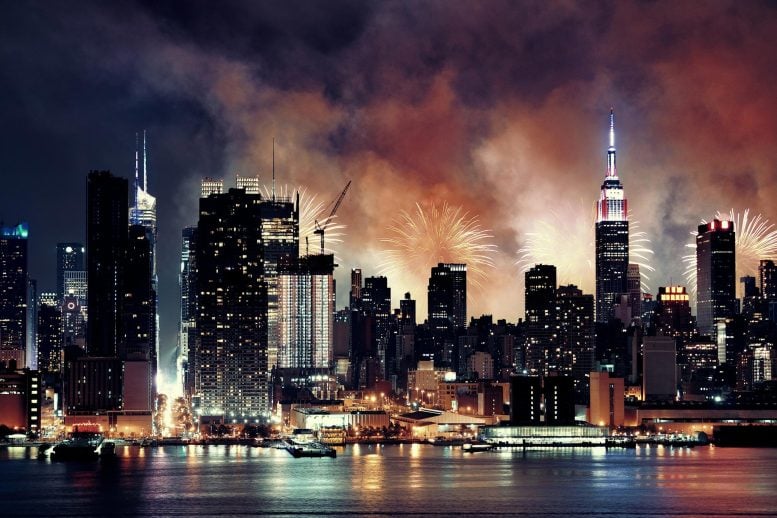
Researchers from NYU Langone Health observed a dramatic increase in air pollution levels in Manhattan following Macy’s Fourth of July fireworks show, with pollutant concentrations far exceeding those from recent wildfire smoke.
The study revealed that such pollution persists for hours and is accompanied by a rise in hazardous metals in the East River. Ongoing research aims to explore the broader health implications of these emissions, underscoring a need for public caution and preventive measures during such displays.
Fireworks Pollution in Manhattan: A Concerning Study
In 2023, roughly 60,000 firework shells exploded above Manhattan’s East River as part of Macy’s Fourth of July show. The resulting air pollutant levels were many times higher in the hours after the display than those seen when smoke from a Canadian wildfire had blanketed the area a month before.
This is according to the results of a new study, led by researchers at NYU Langone Health, which measured air quality just before and after the Independence Day event, one of the largest in the United States. Tiny particles of hazardous metals and organic compounds peaked at 3,000 micrograms per cubic meter at an air sampling site near the show and topped 1,000 micrograms per cubic meter at two other nearby locations. By comparison, New York City’s average daily fine-particle concentration is 15 micrograms per cubic meter and reached 460 micrograms per cubic meter from the wildfire smoke in June 2023.
Prolonged Pollution Impact and Water Contamination
The team also found that air quality took several hours to return to baseline levels for most sampling sites, with those closest to the display, such as in Midtown Manhattan, taking as long as 12 hours.
In addition to fine-particle air pollutant increases, water samples collected from the East River had more than double the levels of metals sometimes used to give fireworks their vibrant colors, such as lead, nickel, and antimony, than before the celebration. Notably, the researchers had shown in earlier experiments using rodents and human tissue that lung exposure to such emissions can lead to oxidation, a chemical process in the body that may damage or even kill cells if left unchecked.
Health Implications and Further Research
“Our findings suggest that major firework displays can create a temporary spike in air pollution that may pose a health risk to both humans and the environment,” said study lead author Terry Gordon, PhD, a professor in the Department of Medicine at NYU Grossman School of Medicine.
In a 2020 study by the same team, the authors analyzed 14 years’ worth of air quality samples taken at dozens of sites across the United States by the Environmental Protection Agency (EPA). They found that levels of toxic metals were higher in samples collected around Independence Day and New Year’s Eve than at any other time of the year. Past research from other experts has also assessed pollution from firework displays in other countries and has connected such exposure to lung problems such as asthma, pneumonia, and chronic obstructive pulmonary disease, says Gordon. Gordon is also a member of the department’s Center for the Investigation of Environmental Hazards and the Division of Environmental Medicine.
The new study, set to publish today (August 6) in the Journal of Exposure Science & Environmental Epidemiology, takes a more comprehensive look at how firework pollution travels and lingers after the initial event, the authors say.
Local and National Pollution Trends
For the research, the team collected air quality samples using real-time monitors at four residential sites along the East River near the display launch site in Manhattan and in Long Island City in Queens. To confirm the monitors’ findings, the investigators analyzed hourly air-quality data from both EPA monitors within a 6-mile radius of the show’s launch sites and a network of low-cost particle monitors set up less than a mile away.
Assessing data from EPA monitoring sites in other major cities, the team also documented increases in pollutant levels in Boston, Philadelphia, and Washington, DC, which like New York, showed elevated pollutant levels that lasted between three and 12 hours before returning to baseline.
Mitigation and Future Studies
“While these findings may seem alarming, firework shows can still be enjoyed,” said study senior author Antonio Saporito, BA, a doctoral student at NYU Grossman School of Medicine. “Wearing an N-95 or KN95 mask is a good way to avoid inhaling smoke when standing near a display, especially for children and for those with preexisting heart and lung problems.”
Saporito says that the 24-hour average of airborne particles estimated in the study was 25 micrograms per cubic meter, which falls within the EPA’s health guidelines, although it does surpass those set by the World Health Organization. He adds that the authors did not take into account local, unregulated firework exhibitions that could have also contributed to environmental pollution.
Next, the team plans to repeat their investigation by analyzing data collected during Macy’s 2024 Fourth of July celebration, which was launched over the Hudson River on Manhattan’s West Side, and examine potential health effects tied to such events.
Reference: “Skyrocketing pollution: assessing the environmental fate of July 4th fireworks in New York City” by Antonio F. Saporito, Terry Gordon, Beck Kim, Tri Huynh, Rahanna Khan, Amna Raja, Kristin Terez, Nicole Camacho-Rivera, Rachel Gordon, Julie Gardella, Maria Katsigeorgis, Rodney Graham, Thomas Kluz, Max Costa and David Luglio, 6 August 2024, Journal of Exposure Science & Environmental Epidemiology.
DOI: 10.1038/s41370-024-00701-x
Study funding was provided by NYU Langone.
In addition to Gordon and Saporito, other NYU Langone investigators involved in the study are David Luglio, PhD; Beck Kim, BS; Tri Huynh, BS; Rahanna Khan, MS; Amna Raja, MS; Kristin Terez, MS; Nicole Camacho-Rivera, MS; Rachel Gordon, BA; Julie Gardella, BA; Maria Katsigeorgis, MS; Rodney Graham, BA; Thomas Kluz, BS; and Max Costa, PhD.